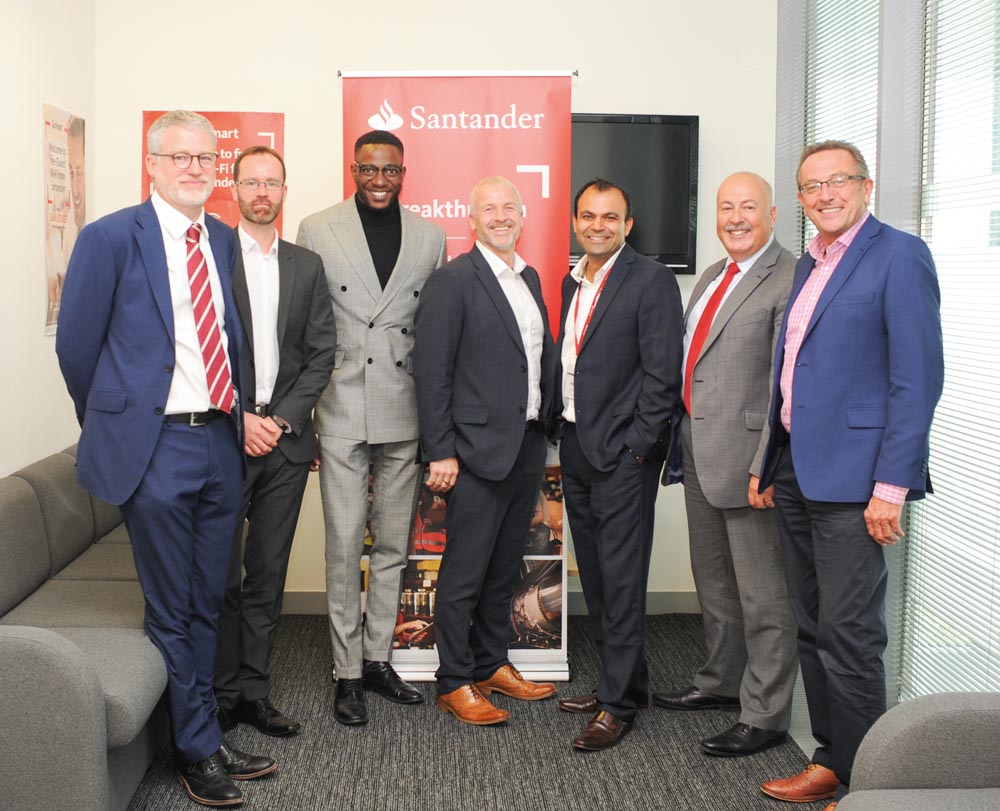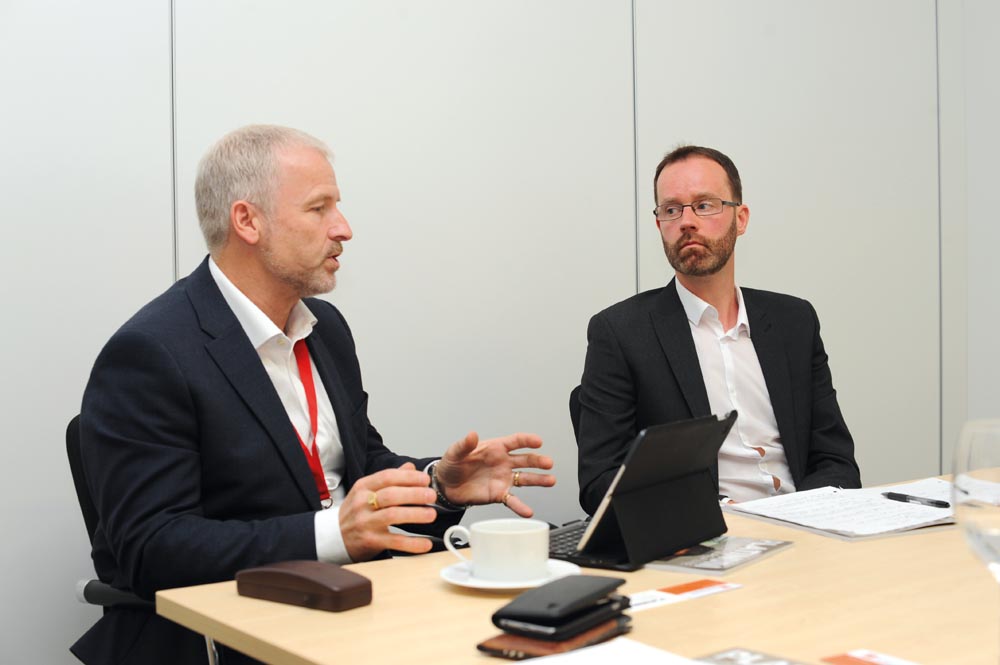
How do businesses innovate? Do we spend enough on research and development? What are the barriers to innovation?
We invited a panel of business owners and innovation experts to discuss the importance of innovation...
The Debate Panel
Colin Berkeley, Regional Director, Santander Business Banking, Santander UK
Bankim Chandra - CEO of Dotsquares, based in Albourne, Sussex. Dotsquares provide web design, development, hosting and digital marketing services. www.dotsquares.com
David Bailey - Innovations team, Santander UK
Peter Lane - Sussex Innovation Centre. Based at the University of Sussex and Croydon, the innovation centre is a leading business incubator for research commercialisation. sinc.co.uk
Maarten Hoffmann - The Platinum Publishing Group
Dr Nicholas Dacre - University of Sussex Business School
Nnamdi Uche - Nnamdi & Co. The Guildford-based fashion brand is looking to disrupt the tailoring industry https://nnamdi.co/
Colin: Welcome everyone. I’ll be facilitating today although our experience of our Breakthrough Moments series events is that there will be a lively debate without me having to do very much at all! We’re here today to talk about innovation and technology. I speak to a lot of SMEs and professionals and I’ve seen that Innovation means different things to different people. I’d be interested to understand what it means to our panel.
Bankim: In simple mathematical formula, for me it’s “innovation + creativity = efficiency”. Business is all about efficiency, how quickly you can deliver to your customer or how quickly you can do a particular task. I’m a strong believer in CRM systems, so we created a customised web-based, mobile-based and watch-based CRM system, and it even links up with Alexa. So I can say: “Alexa, give me information about company X.” You can access all the information through voice command or request reports. It’s all about saving time and making information easily available.
We can link the CRM to Skype and use an application programming interface (API) to link to the bank account, for instance.
It is all about efficiency and how you bring that efficiency to your customer, bringing them greater value at a lower cost.
David: A lot of people don’t feel innovative as they think it’s just about the big ideas. It doesn’t need to be. Innovation is about working out ways to test ideas, seeing if they're going to work and being brave enough to stop investing time and valuable resource in pet projects if it's clear it won’t work.
You have to test ideas or products, it gives you the confidence to decide: “Yes, let’s invest something in this. We know it’s going to work. We have all these proof points. Let’s take it forward.”
Peter: Creativity is in extremely short supply within most work places because a lot of it is to do with how you engage, and having the time to engage. It’s about engaging with people outside of the building. People generally aren’t creative on their own. They require stimulus that challenges them in completely different ways.
It’s also something that we lose as we get older – or at least we become less open to creativity as we get older because we have preconceptions of what is or what isn’t possible. It’s good to be forced to think outside of your comfort zone.
If you have an idea or a new product, innovation is about how you commercialise it or put it into practice – it’s a different set of skills. It’s about how you look at the business model, how you intimately understand the customer and the problems, their needs and likes and then how you evolve a commercialisation strategy.
I think there’s a fear within large organisations of knowing how to give people time and space to innovate and be creative.
Innovation within a company can become quite inwardly focused and it tends to become incremental about the products that you have or the services that you deliver.
Maarten: I heard a fascinating story about Artificial Intelligence (AI) on Radio 4. Most of us are a little confused about AI and we wait for someone to explain its use. This story explained how it was used in Moorfields Eye Hospital. They used machine learning technology to study thousands of historic eye scans to identify signs of eye disease. They found the AI system can recommend the correct referral decision for over 50 eye diseases with 94% accuracy, matching world-leading eye experts.
And it will only get better, no doubt soon exceeding the human experts.
Nicholas: Innovation is the realisation of creativity but for SMEs, the big challenge is, how do you manage creativity for it to become something tangible and of business worth? Ideally there should be a greater amount of autonomy to allow your employees to innovate and be creative. But what SMEs really tend to be interested in is focused creativity; creativity with a value at the end of it, with an output that the business can actually use.
From a more academic and student perspective, one of our roles at university is giving potential future employees the skills to think creatively and learning how to apply that in a business context.
Nnamdi: Creativity, for me, contributes to innovation, and innovation is basically problem solving, helping my business make more money by doing something in a much less expensive way, by using or bringing in something new.
Bankim: Sometimes I feel SMEs don’t want to be the first ones to try new technologies, whereas corporates can try new ideas. If it fails it can go into the criteria of “We tried and we can work on more” whereas start-ups and SMEs want to see a proven formula. It’s all about having the resources to cope with failure.
Nicholas: So creativity in your environment is used very much as a problem solving exercise in order to be able to innovate. From a business perspective, in terms of creativity, we are seeing tools like escape rooms, gamification and things like that that businesses can use to try and engage their employees and collaborate with external partners to drive more creativity and innovation.
Nnamdi: One of the major ways we use creativity is by creating partnerships. You can learn so much when you work together.
I started out as a fashion designer but when I had issues with my website, I had to learn coding and become strong on the technical issues, which is effectively innovating, especially when the coding isn’t working and I have to problem solve.
Colin: It is interesting that when I asked what innovation means to people, everybody around the table linked it to creativity.
A case of too much technology?
David: There are advantages of a hybrid model. People are starting to push back a little bit against digital just because there’s a feeling that something has been lost as technology has taken over people’s lives. People have a high expectation that technology will enable all sorts of things and things have to be instant, but there’s always a space for the human interaction element. John Lewis has a successful model because it uses a digital innovation but people know there is always a person they can talk to. There is a perception of trust and service.
Colin: We recognise that our customers want to interact with us in different ways. Sometimes the same customers want to interact with us in several different ways, it isn’t a “one size fits all”. Sometimes they will go to a branch, sometimes they will bank online, sometimes both. We call it omnichannel. We want our customers to be able to interact with us in any way they want to, at any time, in any combination, and that’s what we’re developing. We spend a lot of time talking to customers to try and understand what it is that they want. Anything we do will be copied almost immediately, so it’s got to be about the value-add and the service.
Maarten: We embrace technology yet resist it as well. If we became a solely online magazine, with all the 47,000 other online magazines, we will just disappear into the ether. So we are loyal to the printed format.
But we use technology to increase efficiencies. The cost of printing has actually come down because of the innovative ways they are printing, although the cost of paper is doing nothing but going up. Within the office, we grab any technology we can get our hands on. Everything that we can find that makes our job easier, we grab it. So we have a huge appetite on one side and on the other side we’re knocking it back as fast as we possibly can.
How to encourage innovation?
Peter: At the Innovation Centre we run a student start-up competition called Start-Up Sussex. In the first year we did it, the would-be entrepreneurs would write business plans, then a panel would judge them and we’d give the winner a couple of grand. It was dreadful. It was so depressing because people won some money and they didn’t have the foggiest idea what to do with it. The business plans were mostly a waste of time.
Our passion became creating an experiential learning course. We wanted people to learn how to assess the difference between an idea and an opportunity. To help people engage with customers and understand exactly what they are thinking. We got the entrepreneurs to pitch to real-life investors and business-owners.
Nnamdi: My experience has been that running an actual business and winning competitions are completely different things. It is nice to win a competition and the prize money is great but it is never enough to make a tangible difference to a business.
Peter: You’re quite right, but the funds are actually a very small piece of the jigsaw. If you have a strong business idea, winning a competition is a strong validation. It may also help generate interest from first-stage investors.
Bankim: It’s great that you’re running this programme and encouraging students to come up with ideas. I’ve been part of Young Enterprise for many years as a business advisor, going every week, discussing the idea and then helping that idea into a business. You see great ideas but they don’t have the business skills. I do agree with Nnamdi, that you need that support and business skills at the same time. For every business it’s the contacts which are required at the start, and you need to have that luck and then the right funding in order to take that next step. Everything requires money, no matter how good your idea is.
Peter: We’ve evolved the model at the Sussex Innovation Centre, and we have an in-house team to help small businesses overcome all the hurdles.
Application of technology
Bankim: Through usage of technology we created an augmented reality app. We use this at expos, where people use the augmented reality to answer question on our stand and win prizes. We were showing it to one of our customers and he said “That would work very well in museums.” You could stand in front of a painting, open that app and access information and the history about the painting.
IKEA have got this app. With the augmented reality, you can see how a piece of decoration will look on a table, for instance.
The power of connecting to people
Peter: We’re trying constantly to make connections with larger companies to come and experience some of the potential new technologies coming out of academics at Sussex.
Maarten: The beauty of being connected with a university is that it’s pumping out hugely talented people with some fabulous ideas. You are right on that doorstep to suck that talent in.
Peter: A lot of our job is connecting people. Even if they are in the room next door to each other they wouldn’t know why they should be talking to each other. So it’s very much a hub, a connection and a network. I would ask: “Can I introduce you to someone who perhaps has done this before? Can we advise you on what kind of IP protection you might need to have in place? Can I introduce you to a free-hour lawyer or a patent attorney?”
Nnamdi: Personally connections have helped me a lot. I didn’t know anything about proper accounting and then I have a friend from church who just did the whole thing for me. He created a spreadsheet for me when I started and I still use it.
David: The contacts that you have are powerful. It's about expanding this network. I love the idea of bringing together the energy of young people with brilliant ideas coming straight out of university with people who have experience and can offer valuable advice.
Colin: It’s always about connections. We actively work with our customers to help them make the right connections, whether that be with professional services, other SMEs who have been through similar experiences or our university partners. You may have a great idea but how can you make money out of it? Linking people together and mentoring is very powerful.
Should we embrace new technology?
Maarten: When it comes to technology, it is easy to act like lemmings. Does everybody need an app? No, they don’t!
I read something like 33% of all apps are never downloaded. No-one ever touches them. I’m continually fielding calls and emails from people saying I need an app for the magazine. Well, actually, no I don’t. More people need to say no to technology that doesn’t actually work for them.
Colin: You see it on Dragons’ Den quite a lot where somebody will stand up, make their presentation and the Dragons say: “You’ve come up with a fantastic solution to something that isn’t actually a problem. It’s lovely but no-one is going to buy it because it doesn’t actually add any value.
Bankim: There should be a separate department in a business whose role it is to look at what’s happening in technology, looking at the papers which are published by big analyst companies like Gardner & Forrester. That department reads those articles and understands what’s happening in technology, and can apply those innovations that actually help the business. On the subject of apps, an app doesn't necessarily need to be external. It can be something within the company which is used by staff members
We recently did a gamification app for a large car manufacturing company. We had the hardware and software integrated into an app which assessed: How quickly are they making the car? How quickly are the bolts, nuts, wheels assembled? And then we created a leader board, which helps increase productivity.
Peter: What a lot of organisations struggle with is that if you innovate you’ve got to accept, as children do, that it might not work. And if it doesn’t work, who cares? Let’s move on.
Nicholas: The university is a great place where we try and embed that culture of “Don’t be afraid to fail” because it’s the place to fail and it is part of the learning journey.
Nnamdi: Someone who was not on my team suggested that we use Chatbots to get people in from Facebook, and it’s something that I wouldn’t have looked at otherwise. A Bot can chat to you and link you straight to my website. They’re more intelligent now and they can ask you what you want. This will save me time and money. If it works well it’s something that I would invest in.
Should we all be Innovators?
Nicholas: The field work that we’ve done at the university suggests that with the smaller businesses, key people within the company are assigned creative responsibilities and job roles. What is key is that these individuals aren’t operating in isolation. You want this creativity to permeate throughout the organisation.
It can come from the top, from the CEO or CFO, but it also can come from the customers, injecting new ideas into the organisation. The question is how do you then capitalise on that? How do you make it something tangible that is of worth? How do you embrace new ideas?
Nnamdi: I did some coding at university but not very much. It was just basic C++ but now I’ve learned some more and did some courses on EDX and practised it. We have a tech guy but it is important to understand the technology, and I can step in and help when we have problems. I like problem solvers because they will help you succeed. I have to think creatively because what we are doing has never been done before, so it’s brand new. The good ideas come from me thinking simply; often people would try and do something complex, but I would suggest something quite simplistic. But now everyone thinks like that because that is our business culture.
David: You could argue that an innovation team almost needs to do itself out of a job within two or three years because they should drive the innovation culture to permeate through the business. Innovation teams cannot work in isolation. Every idea we investigate or try to solve. If the idea has not already come from the business we’ll look for sponsorship within the business. We want the bank staff to say: “We’ve identified this customer problem and we think we have a way to solve. Can you help us to work it through?” That collaboration is really critical.
Nicholas: In the banking sector you guys are facing open banking, FinTech, all these types of innovation. Do you feel pressure that you need to innovate in these particular areas?
David: Absolutely, we've been thinking about what the future holds. There are a lot of unknowns, so we have been doing some testing and learning and trying ideas out. Once we have gone through the testing processes we can look at taking new ideas forward. We try and encourage colleagues to say “If you have an idea come and tell us about it and we can help you bring it to life. We can help you test something quite quickly and then see whether it’s worth taking forward and investing more on that idea."
While we may have resources as a bank that allow us to innovate, we recognise the flexibility and speed of decision making that smaller businesses have. There are necessary constraints in a large corporate environment, particularly within financial services.
Do we invest enough money in innovation?
Colin: I heard an item on Radio Four, discussing a single IT system for the NHS, which up to now has always failed. Apparently, the NHS spends about 1% of their budget on IT de-velopment. They are very much more advanced in the States, and over there they spend 5%. Do we think SMEs understand that they sometimes need to get their cheque book out to do that or does the fear of failure put them off too much?
Peter: I ran a business for 20 years with my brother and sister. As an SME you are always looking at the bottom line, you are always thinking about money and it becomes quite difficult to justify some of the behaviours we’ve been talking about. However, the world is a very fast-moving place now businesses really have no choice but to innovate. It’s ‘do or die’.
Time to think
Google has an employee innovation initiative known as the “20 Per Cent Time” policy. The concept allows employees to dedicate 20% of their working hours to projects they think will most benefit Google. Is this a concept that we should introduce?
Peter: Google encourage employees to get out of the building, experiment or whatever else they carry out in trying to add value to the business. It’s a great model and it’s fantastic if you’ve got billions of dollars sitting in the bank that allow you to be able to behave in that way.
Maarten: There’s no difference between the Google model with all their billions and an SME just finding thinking time. It’s experimental time. Thinking time is the most undervalued thing on the planet. It is invaluable to go and sit in a coffee bar without a phone and take the time to think.
Peter: The Google ethos is for the staff to follow their passion. None of us do anything unless we’re passionate about solving a problem. It’s a tremendous motivator for employees rather than just sitting there saying “This is what I’ve got to do and at the end of the day I do this and then I get home.” Engaging your employee base is vital. An interesting way of spurring that creativity and innovation could be to bring something completely unexpected into the room, maybe as professor of psychology or whatever, to say “Let’s talk about customer behaviours.”
David: Actually we do have a psychologist that we use as part of our testing process. It’s absolutely brilliant because they can bring clarity to how people actually think, how they are likely to respond and what they care about.
Peter: One disadvantage of the constant access to phones is that it leaves you almost time-starved to think laterally or creatively about your business.
David: I believe there are side benefits in allowing your staff the time to innovate, particularly with regards morale and happiness. Obviously you have to run your business, but if staff feel their ideas are heard and they have a contribution to make outside their daily tasks this benefits everyone.
David: There’s a continuum from a cost perspective in terms of what you can do as well. But there are lots of tools out there that enable you use technology without having to commit huge resources. Even within the bank we’re really being encouraged to test more before we go and build something. With SMEs it’s just getting comfortable with finding ways to test an idea out before investing too much of their limited resource and time.
Bankim: A lot depends on the business owner; how technology-oriented are they? How long can your business sustain itself without innovation?
What are the biggest barriers to innovation for SMEs?
Bankim: The fear of failure. One solution is to use people in the right part of the world to get the maximum out of them. We have development centres in India. You have to use the right resources form the right part of the world in order to get the best for your customers.
At the same time we invest in apprentices. I strongly believe in the apprenticeship scheme over here. You get the best people – it’s a bit of a hit and miss process, but still worth giving people a chance.
Maarten: Time and money!
Nicholas: There are two types of employees. You get employees who get given a task and they’ll say ‘That’s not part of my job description.’ And then you get other employees who are given a task that they’ve never dealt with before who say ‘This is exciting. I’ve never done this before. How do I overcome this issue or that particular challenge?’” For organisations to survive they need the latter.
Colin: We started off by talking about what innovation means – and I’ve now got quite a different idea of what innovation can mean which is that it’s about being creative to solve problems, to find solutions, not being afraid to fail and accepting that when innovating probably quite a lot of what they try is not going to work first time. It’s very much about a state of mind – if a business owner wants to be creative to innovate he can drive this through his business and enable his employees to be part of this too.
---
Calling SMEs - If you are interested in finding out more about how Santander can help your business, contact mailto:colin.berkeley@santander.co.uk
Or visit http://santander.co.uk/business







